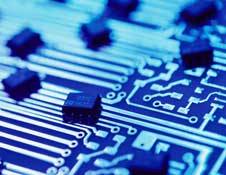| << Chapter < Page | Chapter >> Page > |
The semiconductor industry is one of the fastest growing manufacturing sectors in not only the United Statesbut also in the world. According to the American Electronics Association, the domestic sales of electronic components haveskyrocketed, jumping from $127 billion to $306 billion over the course of the 1980’s. In the first three quarters of the 2003fiscal year alone, the export of technology goods from the United States increased by $19 billion [1].
The word “semiconductor” technically refers to any member of a class of solid, crystalline materials that ischaracterized by an electrical conductivity better than that of insulators (e.g., plastic) but less than that of good conductors(e.g., copper) [2]. Semiconductors are particularly usefulas a base material in the manufacturing of computer chips, and the term semiconductor has actually come to be synonymous with thecomputer chips, themselves. However, semiconductors are not only used in computers. Computers only make up 44% of entire industryconsumption (see [link] ). Semiconductors are also used for military, automotive, industrial, communications, and other consumer purposes.

Semiconductors seem to be anywhere and everywhere throughout our everyday lives, yet it is surprising howlittle most people know about how they actually work or about the potentially devastating effects their manufacturing can have on theenvironment and human health.
Much of the study of nanotechnology has been centered on the manufacturing of semiconductors. Though there are a number of highly anticipated applications for nanotechnology in other fields,notably in medicine and in biotechnology, the most tangible results thus far can be argued to have been achieved in the semiconductorindustry.

For example, Intel recently unveiled its first products based on a generation of 90-nanometer processtechnology, and its researches and engineers have built and tested prototype transistors all the way down to the 22-nanometer range.Currently, Intel scientists and engineers are working on identifying new materials such as carbon nanotubes and nanowires toreplace current transistors, and in particular they hope to develop a “tri-gate” transistor approach that would enable chip designersto build transistors below the 22-nanometer range [4].

Notification Switch
Would you like to follow the 'Pdf generation test course' conversation and receive update notifications?